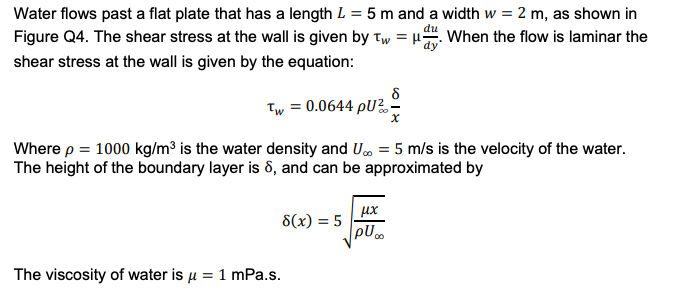a) Estimate the drag force on the plate. You may use the expression ?? = ∫ τ?dA b) When the flow becomes turbulent, we can approximate the velocity gradient at the wall as constant, ∂? ∂? = ?. If the total drag force is 300 N, find ?. c) When the fluid is heated to 90oC, the density drops slightly and the viscosity decreases a lot, and engineers observe that the equation, τ? = 0.0644??∞ 2 δ ? , becomes less accurate. Explain why this might occur (1-2 sentences).
a) Estimate the drag force on the plate. You may use the expression ?? = ∫ τ?dA b) When the flow becomes turbulent, we can approximate the velocity gradient at the wall as constant, ∂? ∂? = ?. If the total drag force is 300 N, find ?. c) When the fluid is heated to 90oC, the density drops slightly and the viscosity decreases a lot, and engineers observe that the equation, τ? = 0.0644??∞ 2 δ ? , becomes less accurate. Explain why this might occur (1-2 sentences).
Elements Of Electromagnetics
7th Edition
ISBN:9780190698614
Author:Sadiku, Matthew N. O.
Publisher:Sadiku, Matthew N. O.
ChapterMA: Math Assessment
Section: Chapter Questions
Problem 1.1MA
Related questions
Question
a) Estimate the drag force on the plate. You may use the expression ?? = ∫ τ?dA
b) When the flow becomes turbulent, we can approximate the velocity gradient at the wall as constant, ∂? ∂? = ?. If the total drag force is 300 N, find ?.
c) When the fluid is heated to 90oC, the density drops slightly and the viscosity decreases a lot, and engineers observe that the equation, τ? = 0.0644??∞ 2 δ ? , becomes less accurate. Explain why this might occur (1-2 sentences).

Transcribed Image Text:Water flows past a flat plate that has a length L = 5 m and a width w = 2 m, as shown in
Figure Q4. The shear stress at the wall is given by Tw=H. When the flow is laminar the
shear stress at the wall is given by the equation:
8
Tw = 0.0644 pU²-
Where p = 1000 kg/m³ is the water density and U∞ = 5 m/s is the velocity of the water.
The height of the boundary layer is 8, and can be approximated by
8(x) = 5
The viscosity of water is μ = 1 mPa.s.
μχ
pU...
Expert Solution
This question has been solved!
Explore an expertly crafted, step-by-step solution for a thorough understanding of key concepts.
Step by step
Solved in 3 steps

Knowledge Booster
Learn more about
Need a deep-dive on the concept behind this application? Look no further. Learn more about this topic, mechanical-engineering and related others by exploring similar questions and additional content below.Recommended textbooks for you

Elements Of Electromagnetics
Mechanical Engineering
ISBN:
9780190698614
Author:
Sadiku, Matthew N. O.
Publisher:
Oxford University Press

Mechanics of Materials (10th Edition)
Mechanical Engineering
ISBN:
9780134319650
Author:
Russell C. Hibbeler
Publisher:
PEARSON

Thermodynamics: An Engineering Approach
Mechanical Engineering
ISBN:
9781259822674
Author:
Yunus A. Cengel Dr., Michael A. Boles
Publisher:
McGraw-Hill Education

Elements Of Electromagnetics
Mechanical Engineering
ISBN:
9780190698614
Author:
Sadiku, Matthew N. O.
Publisher:
Oxford University Press

Mechanics of Materials (10th Edition)
Mechanical Engineering
ISBN:
9780134319650
Author:
Russell C. Hibbeler
Publisher:
PEARSON

Thermodynamics: An Engineering Approach
Mechanical Engineering
ISBN:
9781259822674
Author:
Yunus A. Cengel Dr., Michael A. Boles
Publisher:
McGraw-Hill Education

Control Systems Engineering
Mechanical Engineering
ISBN:
9781118170519
Author:
Norman S. Nise
Publisher:
WILEY

Mechanics of Materials (MindTap Course List)
Mechanical Engineering
ISBN:
9781337093347
Author:
Barry J. Goodno, James M. Gere
Publisher:
Cengage Learning

Engineering Mechanics: Statics
Mechanical Engineering
ISBN:
9781118807330
Author:
James L. Meriam, L. G. Kraige, J. N. Bolton
Publisher:
WILEY